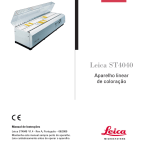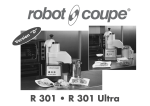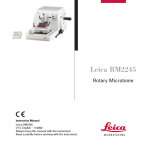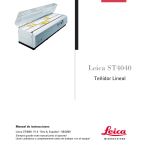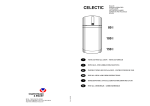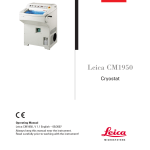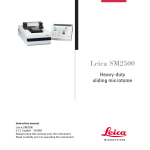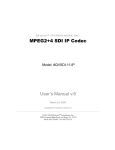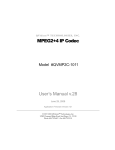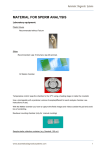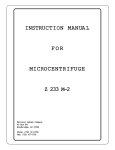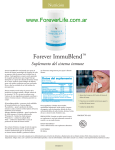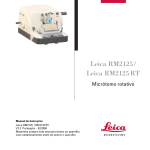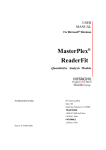Download Leica ST4040 - Leica Biosystems
Transcript
Leica ST4040 Linear Stainer Instruction Manual Leica ST4040 V1.4 - Rev A, English – 06/2009 Always keep this manual near the instrument. Read carefully prior to operating the instrument. IMPORTANT NOTE The information, numerical data, notes and value judgments contained in this manual represent the current state of scientific knowledge and state-of-the-art technology as we understand it following thorough investigation in this field. We are under no obligation to update the present manual periodically and on an ongoing basis according to the latest technical developments, nor to provide our customers with additional copies, updates etc. of this manual. For erroneous statements, drawings, technical illustrations etc. contained in this manual we exclude liability as far as permissible according to the national legal system applicable in each individual case. In particular, no liability whatsoever is accepted for any financial loss or consequential damage caused by or related to compliance with statements or other information in this manual. Statements, drawings, illustrations and other information as regards contents or technical details of the present manual are not to be considered as warranted characteristics of our prod- ucts. These are determined only by the contract provisions agreed between ourselves and our customers. Leica reserves the right to change technical specifications as well as manufacturing processes without prior notice. Only in this way is it possible to continuously improve the technology and manufacturing techniques used in our products. This document is protected under copyright laws. Any copyrights of this document are retained by Leica Biosystems Nussloch GmbH. Any reproduction of text and illustrations (or of any parts thereof) by means of print, photocopy, microfiche, web cam or other methods – including any electronic systems and media – requires express prior permission in writing by Leica Biosystems Nussloch GmbH. For the instrument serial number and year of manufacture, please refer to the name plate at the back of the instrument. © Leica Biosystems Nussloch GmbH Issued by: Leica Biosystems Nussloch GmbH Heidelberger Str. 17 - 19 D-69226 Nussloch Germany Serial No.: .............. ...................................................... Year of Manufacture: ............................................... Phone: +49 6224 143-0 Fax: +49 6224 143-268 Internet: http://www.microsystems.com Leica ST4040 – Linear Stainer Country of Origin: Federal Republic of Germany 3 Table of Contents IMPORTANT NOTE ........................................................................................................................................................................................... 3 1. 1.1 1.2 Important Information .......................................................................................................................................................................... 6 Symbols used in this manual and ....................................................................................................................................................... 6 Designated use ...................................................................................................................................................................................... 7 2. 2.1 2.1.1 2.1.2 2.1.3 Safety ....................................................................................................................................................................................................... 8 Safety instructions ................................................................................................................................................................................ 8 Transport and installation ................................................................................................................................................................... 8 Operating the instrument ..................................................................................................................................................................... 9 Cleaning and maintenance ............................................................................................................................................................... 10 3. Installation ........................................................................................................................................................................................... 11 3.1 3.2 3.2.1 3.3 3.4 3.4.1 Site requirements ................................................................................................................................................................................ 11 Unpacking the instrument .................................................................................................................................................................. 12 Repacking the instrument ................................................................................................................................................................. 12 Installing the instrument ..................................................................................................................................................................... 13 Standard delivery ‘basic instrument’ and general accessories ................................................................................................. 14 Standard delivery ................................................................................................................................................................................ 14 Basic instrument ST4040 - single load model ................................................................................................................................ 14 Basic instrument ST4040 - double load model (for double row staining) ................................................................................. 14 3.4.2 General accessories .......................................................................................................................................................................... 15 3.5 Electrical connections ........................................................................................................................................................................ 16 3.5.1 Adjusting the voltage selector .......................................................................................................................................................... 16 3.5.2 Connecting the power chord to the ................................................................................................................................................. 17 3.6 Installing the accessories .................................................................................................................................................................. 17 3.6.1 Installing the water inlet hose .......................................................................................................................................................... 17 3.6.2 Installing the drain hose .................................................................................................................................................................... 17 3.6.3 Installing the exhaust air hose ......................................................................................................................................................... 17 3.6.4 ..................................................................................................................................................................... Placing the instrument in its ........................................................................................................................................................................................................................ ..................................................................................................................................................................................... permanent position 18 3.6.5 Connecting the inlet hose to the tap ................................................................................................................................................ 18 3.6.6 Leveling the instrument ..................................................................................................................................................................... 18 3.6.7 Inserting the activated carbon filter ................................................................................................................................................ 19 3.7 Plugging the power chord into ...................................................................................................................................................................................................... the wall outlet 19 4. 4.1 4.2 4.2.1 4.3 4.3.1 Installation of the Optional Load/Unload Station ......................................................................................................................... 20 Site requirements ................................................................................................................................................................................ 20 Unpacking the optional load / unload station ....................................................................................................................... 20 Repacking the optional load / unload station ...................................................................................................................... 20 Standard delivery and accessories - optional load / unload station .......................................................................................... 21 Standard delivery - optional load station ......................................................................................................................................... 21 Accessories - optional load station ................................................................................................................................................. 21 4.3.2 Standard delivery - optional unload station ................................................................................................................................... 21 4 Instruction Manual V 1.4 – 06/2009 Table of Contents Accessories - optional unload station ............................................................................................................................................ 21 4.4 Installation ............................................................................................................................................................................................ 22 4.4.1 Installing the optional load station ................................................................................................................................................... 22 4.4.2 Installing the optional unload station .................................................................................................................................................. on the right of the basic instrument ..................................................................................................................................................... 25 4.5 Changing the guide ramps for slide rack carriers ......................................................................................................................... 28 5. Instrument Properties ........................................................................................................................................................................ 29 5.1 Technical Data ..................................................................................................................................................................................... 29 6. Operation .............................................................................................................................................................................................. 30 6.1 Setting up the instrument ................................................................................................................................................................... 30 6.2 Preparing the instrument for staining: inserting and filling the stations .................................................................................... 30 6.3 Staining in two rows ........................................................................................................................................................................... 31 6.3.1 Doubling the specimen throughput ................................................................................................................................................. 31 6.3.2 Carrying out two different, but matching, staining protocols simultaneously ......................................................................... 31 6.3.3 Carrying out two different staining protocols (two subsequent single loads) ......................................................................... 31 6.4 Control panel functions ...................................................................................................................................................................... 32 6.5 Switching on mains and selecting direction of travel and alarm volume .................................................................................. 33 ........................................................................................................................................................................................................................... 33 6.5.1 Selecting direction of travel .............................................................................................................................................................. 33 ........................................................................................................................................................................................................................... 33 6.5.2 Selecting alarm volume ..................................................................................................................................................................... 34 ........................................................................................................................................................................................................................... 34 6.6 Switching on mains without selecting direction of travel/alarm volume .................................................................................. 34 ........................................................................................................................................................................................................................... 34 6.6.1 Stand-by mode .................................................................................................................................................................................... 34 ........................................................................................................................................................................................................................... 34 6.7 Programming ........................................................................................................................................................................................ 35 6.8 Staining ................................................................................................................................................................................................. 36 6.8.1 Selecting a program ........................................................................................................................................................................... 36 ........................................................................................................................................................................................................................... 36 6.8.2 Preparing and inserting the slide racks .......................................................................................................................................... 37 6.8.3 Starting the selected program .......................................................................................................................................................... 38 ........................................................................................................................................................................................................................... 38 6.9 Removing the slide racks ................................................................................................................................................................... 39 6.8.4 Interrupting a program ....................................................................................................................................................................... 39 ........................................................................................................................................................................................................................... 39 6.9.1 Removing the last slide rack ............................................................................................................................................................. 40 ........................................................................................................................................................................................................................... 40 6.10 Removing the slide racks in instruments equipped with optional unload station ................................................................... 40 ........................................................................................................................................................................................................................... 40 6.11 Finishing work ..................................................................................................................................................................................... 41 ........................................................................................................................................................................................................................... 41 7. Trouble Shooting ................................................................................................................................................................................. 42 8. 8.1 8.2 Cleaning and Maintenance .............................................................................................................................................................. 44 Cleaning ................................................................................................................................................................................................ 44 Maintenance ........................................................................................................................................................................................ 46 9. Warranty and Service ........................................................................................................................................................................ 47 Leica ST4040 – Linear Stainer 5 1. Important Information The instruction manual for the Leica ST4040 includes chapters on the following subjects: Chapter 1 Chapter 2 Chapter 3 Chapter 4 Chapter 5 Chapter 6 Chapter 7 Chapter 8 Chapter 9 Chapter 10 Appendix 1 6 Structure of this manual • Table of contents • Important information on this manual Safety • Read this chapter before operating the instrument Installation • Unpacking and installation • Standard delivery, accessory range Installation Optional load / unload station • Unpacking and installation • Standard delivery, accessory range Instrument features • Technical data Operation • Controls • Setup and daily use Trouble Shooting • Operating errors • Trouble shooting Cleaning and Maintenance Warranty and Service EC Declaration of Conformity Staining protocols Leica ST4040 1.1 Symbols used in this manual and their meaning Warnings appear in a grey box and are marked by a warning triangle. Notes i.e. important user information appear in a grey box and are marked by an information symbol. (5) (Fig. 5) Figures in brackets refer to item numbers in drawings or to the drawing itself. Instrument type: All information given in this instruction manual applies only to the instrument type indicated on the title page. A name plate indicating the instrument serial number is attached to the back of the instrument. Required information for all enquiries: For any enquiries please specify: • Instrument type • Serial number Instruction Manual V1.4 – 06/2009 1. Important Information General 1.2 This instruction manual includes important instructions and information related to the operating safety and maintenance of the instrument. The instruction manual is an important part of the product. It must be read carefully before first using the instrument and must always be kept with the instrument. The Leica ST4040 is an automated linear stainer for the preparation of histological and cytological routine stainings. It is designed for use in pathology laboratories, and only for performing the following tasks: It will be necessary to add appropriate instructions to this instruction manual, if imposed by existing national regulations or by laws on accident prevention and environmental protection in the country of the operating authority. Designated use • Staining of thin sections of tissue specimens or of cytological samples, attached to microscope slides Any use of the instrument other than its designated use is considered improper. Read this instruction manual carefully before attempting to use or operate the instrument. Please pay particular attention to the safety instructions in chapter 2. Please do read this information, even if you are familiar with the operation and use of Leica products. Leica ST4040 – Linear Stainer 7 2. Safety 2.1 Safety instructions This instrument has been built and tested in accordance with the following safety regulations on electrical measuring, control, regulating and laboratory devices. In order to maintain this condition and to ensure safe operation, the operator must observe the instructions and warnings contained in this instruction manual. For current information about applicable standards, please refer to the CE declaration of conformity on our Internet site: www.histo-solutions.com 2.1.1 Transport and installation • Do not operate the instrument in rooms where risk of explosion exists! • Do not expose the instrument to direct sunlight (windows)! • Do not install the instrument above a heater! • Install the instrument on an even laboratory bench which must be absolutely level! • Two people are needed to lift / carry the instrument! • Before connecting the instrument to mains, make sure the correct voltage setting, matching the nominal voltage at the site of installation, has been selected! • Upon installing the drain hose make sure there is a gradient from the drain outlet to the waste pipe. • To protect the user from hazardous solvent fumes, make sure to operate the instrument either with the activated carbon filter or the exhaust air hose! 8 Instruction Manual V1.4 – 06/2009 2. Safety 2.1.2 Operating the instrument • The instrument may only be operated by skilled personnel. It may only be operated according to its designated use and in accordance with the instructions given in this manual! • If not only the water tap but also the ball valve has been closed (--> e.g. when setting up the instrument), the tap water flow rate has to be adjusted when starting a program (see also chapters 3.6 and 6.8.3). • While working with reagents (filling / emp-tying the reagent stations, working on the instrument while the lid/s is/are open) appropriate protective gear (lab coat, gloves, safety goggles) must be worn! • The flow rate must not be too fast, to en-sure that the specimens remain firmly at-tached to the slide surface! • Make sure to operate the instrument ei-ther with the activated carbon filter or with the exhaust air hose (--> Chapter 3.6, ‘Installing the accessories’). Even when the instrument is operated according to its designated use, hazardous solvent fumes develop, which are damaging to the operator’s health and do also pose a risk of fire! • Risk of fire, when working with an open flame (Bunsen burner) immediately next to the instrument (solvent fumes)! - Therefore, keep a safety distance of 1 meter! • If a staining program is to be interrupted for an extended period of time, do not leave any slide racks in the tap water sta-tions, in order to prevent them from drying out! • As soon as the alarm is triggered, immediately remove the completed slide rack from the last station or from the unload container of the optional unload station! Otherwise, immersion times for the remaining slide racks will be prolonged! • In case of emergency switch off mains and unplug the power chord! • If ‘Alarm off’ is selected (not recommended!), the instrument must be observed constantly, to make sure all slide racks are removed immediately when reaching the last station! Leica ST4040 – Linear Stainer 9 2. Safety 2.1.3 Cleaning and maintenance • Only technical service engineers authorized by Leica may access the internal components of the instrument for service and repair. Exception: Changing the activated carbon filter is the only maintenance task to be carried out by the user. • Prior to cleaning the instrument, always switch off mains and unplug the power chord! • Dispose of used reagents according to the laboratory regulations in force in your country! • Spilled solvents (reagents) have to be wiped away immediately! - In case of long-term exposure, the lid surfaces are only conditionally resistant to solvents! • When handling cleaning detergents, follow the instructions of the manufacturer and make sure all applicable laboratory regulations are complied with! • When cleaning the instrument, no liquid may enter in contact with any of the electrical connections or get into the interior of the instrument! • Wash the tap water and reagent stations in the dishwasher at a temperature of max. +65 °C. - Use a standard detergent for laboratory dishwashers. At any rate avoid washing the stations at higher temperatures (e. g. in industrial diswashers which run at a temperature of +85 °C), as the stations may become deformed! • The painted surfaces and the control panel are not resistant to xylene or acetone! • For cleaning the instrument, do not use any one of the following: alcohol, detergents containing alcohol (window cleaner!), abrasive cleaning powders, solvents containing xylene or acetone! • To clean the lids, control panel and housing, use mild household detergents; - see safety instruction above for non-appropriate ingredients! 10 Instruction Manual V1.4 – 06/2009 3. 3.1 Installation Site requirements The installation site has to meet the following requirements: • Stable laboratory bench, exactly level, at least 1.60 m wide and 60 cm deep. • Tap water supply at a distance of max. 2 m and drain at a distance of max. 1.50 m from the corresponding inlet and outlet at the back of the instrument. Do not operate the instrument in rooms where risk of explosion exists! Do not expose the instrument to direct sunlight (windows)! Do not install the instrument above a heater! - Please bear in mind: The connections are located at the extreme left on the back of the instrument. • Fume hood at a distance of max. 3.50 m from the instrument, if the instrument is to be operated with the exhaust air hose (otherwise the instrument must be operated with the activated carbon filter)! • Vibration-free floor. • Sufficient open space (70 cm) above the laboratory bench, to ensure trouble-free opening of the lids. • Stable ambient temperature of +10 °C to +35 °C. • Relative air humidity of maximum 80%, noncondensing. • No other instruments which cause vibrations installed nearby. Leica ST4040 – Linear Stainer 11 3. Installation 3.2 Unpacking the instrument The unpacking instructions for all Leica instruments are located in a transparent protective envelope on the outside of the instrument transportation crates. 3.2.1 Repacking the instrument We recommend keeping the original crate and packing material in store, in case the instrument needs to be repacked in the future. The drawing below shows the design of the original crate and packing material. The numbers indicate the sequence of disassembling and reassembling the crate. 9 8 7 6 5 4 3 2 1 12 Instruction Manual V1.4 – 06/2009 3. 3.3 Installation Installing the instrument • To lift, grip the instrument by the transport handles. Two people are needed to lift / carry the instrument, since it weighs 73 kg (see ‘Technical data’, chapter 5.1)! • Install the instrument on the designated bench. • Unscrew the transport handles. • Remove the plastic protective cover from the instrument. • Check all delivered parts against the packing list to verify whether the delivery is complete - see chapter 3.4 ‘Standard delivery ‘basic instrument’ and general accessories’). • For all further installation steps, see chapters 3.5 ‘Electrical connection’ and 3.6 ‘Installing the accessories’. Leica ST4040 – Linear Stainer 13 3. Installation 3.4 Standard delivery ‘basic instrument’ and general accessories 3.4.1 Standard delivery Basic instrument ST4040 - single load model • • • • • • • • • • • • Basic instrument with three-piece lid 27 Reagent stations, plastic 4 tap water stations, complete assy. with inlet valve 1 Drain hose for waste water, 2 m long 1 Tap water inlet hose, 2.50 m long, complete with 3/4“ connection for water tap and replacement gasket 2 Lids for reagent stations 1 Cover for second row 1 Instruction manual ................................................................ 14 0474 80001 1 Tool set, including: • 1 Single-ended open-jaw wrench, size 27 • 1 Single-ended open-jaw wrench, size 13 • 1 Screw driver, 5.5 x 200 mm • 1 Screw driver, 3 x 50 mm 1 Water tap adapter for 1/2“ water taps 3 Disposable plastic films, solvent-resistant, for control panel 1 Set of power chords: • Euro • UK • USA Basic instrument ST4040 - double load model (for double row staining) To use a single load model for double row staining, order the appropriate number (may vary - depends on individual staining applications) of the accessories listed below (see chapter 3.4.2 - ‘General accessories’ for details): • • • • • 14 Reagent stations Tap water stations Lids for reagent stations Slide racks Slide rack carriers Instruction Manual V 1.4 – 06/2009 3. Installation 3.4.2 General accessories • • • • • • • • • • • • • • • • • • • • • Reagent stations, plastic Tap water stations, complete assy. with inlet valve Leica slide racks, metal Sakura slide racks, plastic Adapter for large slides Drain hose, 4 m long Tap water inlet hose, 2.50 m long, complete with 3/4“ connection for water tap Lids for reagent stations Slide rack carriers for Leica slide racks Slide rack carriers for Medite/Hacker slide racks Slide rack carriers for Sakura slide racks Storage container for slide rack carriers, fits on instrument housing Activated carbon filter Exhaust air hose, 2 m long Exhaust air hose, 4 m long Disposable plastic films, solvent-resistant, for control panel (set of 10) Optional load station, left* Optional load station, right* Optional unload station, left* Optional unload station, right* Leica CV5000 adapter for slide racks: • CV5000 slide rack adapter, removable: - slides onto Leica slide racks for coverslipping in Leica CV5000. - up to Leica CV5000 s/nos. ≤ CV026096 • CV5000 stationary slide rack adapter: - for permanent installation in Leica CV5000 for using Leica ST4040 slide racks in CV5000. - starting from Leica CV5000 s/nos. > CV026096) To order accessories, please contact your Leica local sales organization for the latest literature / current order numbers on the full range of Leica ST4040 accessories. *) For accessories for optional load / unload station, please refer to chapters 4.3.1 and/or 4.3.2 respectively! Leica ST4040 – Linear Stainer 15 3. Installation 3.5 Electrical connections • Insert the small screwdriver (3 x 50 mm) into the notch at the lower end of the voltage selector shell. Carefully release the lock, using the screwdriver as a le- 3.5.1 Adjusting the voltage selector The voltage selector is preset to match the nominal voltage of the country of delivery. Nevertheless, it is absolutely necessary that you check the setting of the voltage selector prior to connecting the instrument to mains, to make sure the setting is correct! Connecting the instrument to mains with the voltage selector at a wrong setting can cause severe damage to the instrument! ver. 3 2 • Check the setting showing in window (1). 1 • Does it correspond to the nominal voltage in your laboratory? • If the setting is correct: --> Go to next page (chapter 3.5.2). • If the setting is not correct, the voltage selector must be changed to the correct setting: --> Continue to follow instructions on this page. 16 • Remove shell (2) with fuses (3). • Take the fuses out of the shell. • Pull the voltage selector out of the shell and reinsert it such that the desired setting is visible in the small window (1) of the shell. • Reinsert the shell together with voltage selector and fuses into the corresponding opening at the back of the instrument and apply light pressure until it locks. 1 • Double-check if the correct setting now shows in window (1). Instruction Manual V1.4 – 06/2009 3. 3.5.2 Connecting the power chord to the instrument • Remove the adhesive tape from the mains inlet. 3.6 Installation Installing the accessories 3.6.1 Installing the water inlet hose • Install the inlet hose, which supplies water to the tap water stations. 3.6.2 Installing the drain hose • Select the appropriate power chord (the instrument is delivered with several, countryspecific power chords) and connect it to the mains inlet at the rear of the instrument. • Do not yet plug the power chord into the wall outlet. • Connect the drain hose. Upon installing the drain hose make sure there is a gradient from the drain outlet to the waste pipe. 3.6.3 Installing the exhaust air hose • The unload sensor port remains empty; unless the instrument is operated with optional unload station (see Chapter 4). Leica ST4040 – Linear Stainer • Connect the exhaust air hose (optional!). The instrument may be operated either with the exhaust air hose or with the activated carbon filter. 17 3. Installation 3.6.4 Placing the instrument in its permanent position • Place the instrument in its permanent position on the laboratory bench. • Connect the exhaust air hose to the fume hood, or lead outside. • Insert drain hose into drain. 3.6.5 Connecting the inlet hose to the tap • Connecting to 3/4“ water tap: Connect the ball valve to the water tap and attach the tap water inlet hose to the ball valve. Ball valve closed. • Do not yet open neither water tap nor ball valve (see above)! When setting up the instrument, an adjustment of the tap water flow rate has to be done. This adjustment cannot be done until after the tap water stations have been inserted. - For detailed instructions on the flow rate adjustment, see Chapter 6.8.3! For safety reasons, we recommend using a so-called ‘Aquastop’ device, as commonly used with household appliances. 3.6.6 Leveling the instrument When installed in its final posi-tion on the laboratory bench, the instrument must be exactly level! (see also chapter 3.1 ‘Site requirements’). • Connecting to 1/2“ water tap: Fit the adapter in between water tap and ball valve. 18 • If necessary, the instrument can be slightly readjusted via the adjustable instrument feet. • For that purpose, screw the instrument feet in or out, as needed, until the instrument is positioned horizontally. Instruction Manual V1.4 – 06/2009 3. Installation 3.6.7 Inserting the activated carbon filter If the instrument is not connected to a fume hood (via exhaust air hose), an activated carbon filter must be used! • Insert the activated carbon filter. • Close the front panel. While applying light pressure to the front panel, press the two locking pins to lock the panel into place. • To insert the activated carbon filter, open the hinged front panel: press the two locking pins, which are located on the top right and left on the inside of the front panel. 3.7 • Remove the the activated carbon filter from the package. • Prior to plugging the power chord into the wall outlet, check whether the mains switch is in OFF (‘0’) position. • Write the current date on the filter (to be reminded to replace the filter in time). Leica ST4040 – Linear Stainer Plugging the power chord into the wall outlet • Connect the power chord to the wall outlet. 19 4. Installation of the Optional Load/Unload Station 4.1 Site requirements The installation site has to meet the following requirements: • Stable laboratory bench, exactly level, at least 1.60 m wide and 60 cm deep for the basic instrument, plus an additional 0.30 m of width for each of the optional stations. • Other than that, the same site requirements as listed for the basic instrument apply (see Chapter 3.1). 4.2 Unpacking the optional load / unload station The unpacking instructions for all Leica instruments are located in a transparent protective envelope on the outside of the instrument transportation crates. 4.2.1 Repacking the optional load / unload station We recommend keeping the original crates and packing material in store, in case the load / unload stations need to be repacked in the future. The drawing below shows the design of the original crate and packing material. The numbers indicate the sequence of disassembling and reassembling the crate. 7 6 5 4 3 2 1 20 Instruction Manual V1.4 – 06/2009 4. 4.3 Installation of the Optional Load/Unload Station Standard delivery and accessories - optional load / unload station 4.3.1 Standard delivery - optional load station • • • • 1 Optional load station 5 Reagent stations 1 lid for reagent stations of optional load station 1 Tool set, including: • 1 Hexagon key, size 2.5 • 1 Hexagon key, size 3 • 1 Hexagon key, size 4 • 1 Ring wrench, size 10 Accessories - optional load station • Reagent stations • Lid for reagent stations of optional load station 4.3.2 Standard delivery - optional unload station • • • • • 1 Optional unload station 1 Unload container for optional unload station 1 Lid for unload container of optional unload station 1 Connecting cable for unload sensor 1 Pair of guide ramps no. 2, for slide racks / slide rack carriers by Medite/Hacker and/or Sakura • 1 Tool set, including: • 1 Hexagon key, size 1.5 • 1 Hexagon key, size 2.5 • 1 Hexagon key, size 3 • 1 Hexagon key, size 4 • 1 Ring wrench, size 10 Accessories - optional unload station • Unload container for optional unload station* • Lid for unload container of optional unload station For double loading (staining in two rows) with optional load and/or unload station attached to the basic instrument, order the necessary accessories for the optional load and/or unload station as needed. *) Can also be used for intermediate storage of slide racks prior to coverslipping; (see chapter 6.10 for details). Leica ST4040 – Linear Stainer 21 4. Installation of the Optional Load/Unload Station 4.4 Installation 4.4.1 Installing the optional load station on the left side of the basic instrument • Remove the side panel from the side wall and detach the ground wire from the side wall. • Remove the 4 hexagon socket screws from the left lid (hexagon key, size 4). • Detach the ground wire and pull it out of the instrument (will not be needed any longer.) • Remove the lid. - Keep the screws (will be needed later)! • Remove the 2 black screws from the left side panel (hexagon key, size 3). 22 • Press the Start/Stop button, to move the conveyor frame to the upper position. As soon as the conveyor frame has reached the upper end position, switch the instrument off (ON/OFF button). Instruction Manual V1.4 – 06/2009 4. Installation of the Optional Load/Unload Station 1 • Place the optional load station on the left side of the basic instrument. • Plate (1) which connects optional load station and basic instument is fastened with two Allan screws. In order to establish safe protective grounding, it is essential to fasten plate (1) securely. • Move the optional load station right up to the instrument, inserting the two pins, located on the left and right at the bottom of the optional load station, into the corresponding openings in the basic instrument. • Open the Lid • Tighten the screw on the left wall of the optional load station ring wrench, size10). Leica ST4040 – Linear Stainer • Pull the conveyor frame of the optional load station upwards using both your hands. 23 4. Installation of the Optional Load/Unload Station • Fit the connecting plates attached to the front and rear half of the conveyor frame of the optional load station over the insides of the front and rear half of conveyor frame of the basic instrument. • Lower the conveyor frame (now connected to one single piece) pushing the ON/OFF button. • Use the 4 hexagon socket screws which you have kept (see step 1) to attach the lid of the optional load station to the corresponding hinge (= left hinge of basic instrument). • Bolt the two front halves of the conveyor frames together with two hexagon socket screws (hexagon key, size 2.5). To install an optional load station to the right side of the basic instrument, follow the same steps - carried out laterally reversed. • Bolt the two rear halves of the conveyor frames together with two hexagon socket screws (hexagon key, size 2.5). 24 Instruction Manual V1.4 – 06/2009 4. Installation of the Optional Load/Unload Station 4.4.2 Installing the optional unload station on the right of the basic instrument • Remove the 4 hexagon socket screws from the right lid (hexagon key, size 4). • Remove the lid. - Keep the screws (will be needed later)! • Remove the 2 black screws from the right side panel (hexagon key, size 3). Leica ST4040 – Linear Stainer • Remove the side panel from the side wall and detach the ground wire from the side wall. • Detach the ground wire and pull it out of the instrument (will not be needed any longer.) • Press the Start/Stop button, to move the conveyor frame to the upper position. As soon as the conveyor frame has reached the upper end position, switch the instrument off (ON/OFF button). 25 4. Installation of the Optional Load/Unload Station In order to establish safe protective grounding, it is essential to fasten plate (1) securely. • Place the optional unload station on the right side of the instrument. • Move the optional unload station right up to the instrument, inserting the two pins, located on the left and right at the bottom of the optional load station, into the corresponding openings in the basic instrument. • Open the right lid. • Tighten the screw on the right wall of the optional unload station (ring wrench, size10). 1 • Plate (1) which connects optional unload station and basic instument is fastened with two Allan screws. 26 • Pull the conveyor frame of the optional unload station upwards using both your hands. • Fit the connecting plates attached to the front and rear half of the conveyor frame of the optional unload station over the insides of the front and rear half of the conveyor frame of the basic instrument. Instruction Manual V1.4 – 06/2009 4. Installation of the Optional Load/Unload Station • Bolt the two front halves of the conveyor frames together with two hexagon socket screws (hexagon key, size 2.5). • Use the 4 hexagon socket screws which you have kept (see step 1) to attach the lid of the optional unload station to the corresponding hinge (= right hinge on basic instrument). • Bolt the two rear halves of the conveyor frames together with two hexagon socket screws (hexagon key, size 2.5). • Insert the plug of the unload sensor cable into the unload sensor port on the rear of the basic instrument. • Lower the conveyor frame (now connected to one single piece) pushing the ON/OFF button. Leica ST4040 – Linear Stainer To install an optional unload station on the left side of the basic instrument, follow the same steps - carried out laterally reversed. 27 4. Installation of the Optional Load/Unload Station 4.5 Changing the guide ramps for slide rack carriers To operate the instrument with Medite / Hacker or Sakura slide racks, the standard guide ramps no. 1 for Leica slide racks must be exchanged for guide ramps no. 2 (see ‘Standard delivery - optional unload station’, chapter 4.3.2). 2 2 1 2 1 • Place grooved ramp no. 2 onto the rear pin and use the hexagon key, size 1.5 to fasten the two grub screws in the ramp (clockwise rotation through about 180 °). 1 • Use the hexagon key, size 1.5 to unscrew both ramps no. 1 loosening the two corresponding grub screws in each ramp (counterclockwise rotation through about 180 °). Remove both ramps. 28 • Place plain ramp no. 2 onto the front pin and fasten the front ramp (clockwise rotation of both grub screws through about 180 ° hexagon key, size 1.5). Store ramps no. 1 for future use! Instruction Manual V1.4 – 06/2009 5. 5.1 Instrument Properties Technical Data General Admissions: Nominal supply voltage: VDE, UL, cUL, C-Tick Label available: 100 V AC ± 10 % 120 V AC ± 10 % 230 V AC ± 10 % 240 V AC ± 10 % Nominal frequency: 50/60 Hz Maximum power draw: 150 VA 1 I Protective class : Mains fuses: Circuit breaker manufactured by ETA, 2 A model: 3120-F421-P7T1-W01D-2 A Primary fuses: manufactured by Schurter: model Fst 2 x T8 A Secondary fuses: manufactured by Schurter: model Fst Motor (F1) T 600 mA Electronic (F2) T 1,6 A 1 2 Pollution degree : Overvoltage installation category: II Working temperature range: +10 °C to +35 °C Relative air humidity: Sound intensity level: 1) max. 80 %, non-condensing < 70 dB according to IEC-1010, UL 3101, EN 61010 Dimensions and weight Basic instrument (W x H x D): Basic instrument with optional load and unload station (W x H x D): Optional load / unload station (W x H x D): Working height: 318 mm Weight: (Basic instrument with accessories) (optional load station) (optional unload station) Leica ST4040 – Linear Stainer 1,435 x 444 x 436 mm 1,969 x 444 x 436 mm 267 x 444 x 392 mm 73 kg 16 kg 14 kg 29 6. Operation 6.1 Setting up the instrument To set up the instrument follow all instructions of chapter 6 step by step. 6.2 Preparing the instrument for staining: inserting and filling the stations • Select a staining protocol. (For examples, see Appendix 1: ‘Staining protocols’) • According to the selected staining protocol, determine the order of reagent and tap water stations. • Open all three lids. The Leica ST4040 is equipped with a three-piece lid, thus e n abling the operator to open just one of the two small lids on the right or left of the instrument for loading / unloading slide racks. This system keeps the exposure of laboratory personnel to hazardous fumes to a minimum. • Remove the cover screws from those positions where you have decided to install tap water stations (tap water stations can be installed from positions 3 through 20). • Insert the tap water stations (yellow - see left) and the reagent stations (white). • Make sure that all stations are inserted correctly; the stations must not be jammed (overlapping rims!). • Add reagents according to selected staining protocol. - Do not exceed the maximum volume or remain under the minimum volume! • Close the lid entirely. 30 Instruction Manual V 1.4 – 06/2009 6. 6.3 Operation Staining in two rows 6.3.1 Doubling the specimen throughput • For this type of application, the sequences of reagent / tap water stations in rows 1 and 2 must be identical. • According to the station sequence selected for row 1 (see Chapter 6.2) insert an identical sequence in row 2. • Both rows are run with the same program. 6.3.2 Carrying out two different, but matching, staining protocols simultaneously • Precondition: the program parameters of both protocols must be the same (i.e. both rows are run with the same program). • The two staining protocols are coordinated through the number of reagent stations and/or the concentration or dilution of the reagents (for details, see Appendix 1 - ‘Staining protocols’). Important note to chapters 6.3.1 and 6.3.2 • When staining in two rows, standard slide rack carriers, as for single row staining, are used. • Slide rack carriers located side by side in rows 1 and 2 are inserted laterally reversed into the same notch of the conveyor frame (see left). 6.3.3 Carrying out two different staining protocols (two subsequent single loads) • The two rows are never carried out simultaneously, i.e.: row 1 is run with program 1 - row 2 with program 2, or vice versa. In 6.3.3 the advantage of staining in two rows is that 2 different staining protocols, though not run simultaneously, can be run one directly after another without any delay; whereas in a single load model, stations would have to be rearranged, refilled etc. prior to being able to run the second protocol. Leica ST4040 – Linear Stainer 31 6. Operation 6.4 Control panel functions IMMERSION TIME button Display / select immersion time DISPLAY SCREENDisplay immersion and draining times DRAINING TIME button Display / select draining time AGITATION button Agitation (dips) ON/OFF PROGRAM 1 button Select / program program no. 1 +/- buttons Change displayed parameters 32 ON/OFF button switch on instrument --> stand-by mode MAINS SWITCH connects / disconnects instrument to / from mains (0 = OFF / I = ON) START/ STOP button Start / stop staining programs PROGRAM 2 button Select / program program no. 2 Instruction Manual V 1.4 – 06/2009 6. 6.5 Operation Switching on mains and selecting direction of travel and alarm volume • Switch on mains (O = OFF / I = ON). • The current software version is displayed, in 4 digits, for 10 seconds. • Only during this phase can the direction of travel and the alarm volume be selected and/or changed! • If direction of travel and/or alarm volume have already been selected and you do not want to make any changes to those parameters either: -> go on to Chapter 6.6. 6.5.1 Selecting direction of travel • Press Start/Stop and hold. • Depending on the desired direction of travel press the ‘+’ or ‘-’ button: • Pressing the ‘+’ button: • Right half of display screen (= indication of seconds) lights up: --> Direction of travel to the right (= staining starts from the left). • Pressing the ‘-’ button: • Left half of display screen (= indication of minutes) lights up: --> Direction of travel to the left (= staining starts from the right). Leica ST4040 – Linear Stainer 33 6. Operation 6.5.2 Selecting alarm volume • Press the ‘Immersion time’ button and hold. • Press ‘+’ or ‘-’ respectively: • Each time when pressing a button, the volume changes audibly: • Alarm OFF --> Alarm low --> Alarm loud. If ‘Alarm OFF’ is selected (not recommended!), the instrument must be observed constantly, to make sure all slide racks are removed immediately when reaching the last station! • Proceed to --> 6.6.1 ‘Standby mode’. 6.6 Switching on mains without selecting direction of travel/alarm volume • Switch on mains (O = OFF / I = ON). • The current software version is displayed for 10 seconds. • If no further buttons are pressed during this phase, after 10 seconds the LED of the ON/OFF button lights up. 6.6.1 Stand-by mode • Press ‘ON/OFF’ button. • The fan goes on. • The LED (in the program button) of the program used last lights up (here: ‘Prog 1’) and the programmed parameters are displayed. • Exception: Prior to switching off the mains a program had not yet been fini-shed or a power failure occurred while a program was in progress: • In those cases the instrument does not switch to the stand-by mode but continues the previously interrupted program. 34 Instruction Manual V 1.4 – 06/2009 6. 6.7 Operation Programming Programming must be done while in stand-by mode. The instrument can store 2 programs: (buttons ‘Prog 1’ and ‘Prog 2’). • Select a program (‘Prog 1’ or ‘Prog 2’). • Press the desired button (here ‘Prog 1’) and hold for approx. 5 seconds - until the LED in the button starts flashing. • Press the ‘Immersion time’ button: • The LED in the button lights up. • Use the ‘+/-’ buttons to select the desired value. • Immersion time can be set from 0 seconds up to 99 minutes, 59 seconds. • To set the time, the button can be pressed and released - going up or down step by step - or it can be pressed and held. If the button is pressed and held, the display scrolls faster. • Press the ‘Draining time’ button: • The LED in the button lights up. • Use the ‘+/-’ buttons to select the desired value. Leica ST4040 – Linear Stainer 35 6. Operation • Draining time can be set from 0 seconds to 60 seconds. • Press the agitation button to activate or deactivate ‘Agitation’. • (LED illuminated = ‘Agitation’ activated). • (LED not illuminated = ‘Agitation’ deactivated). • Briefly press the same program button that was selected when you startled programming (here ‘Prog 1’), until the LED in the button lights up. • The programmed parameters are stored. • To select and store parameters for program 2, proceed in identical fashion. 6.8 Staining 6.8.1 Selecting a program • Select the desired program by pressing button ‘Prog 1’ or ‘Prog 2’. • Program selection is only possible in stand-by mode. • LED in the program button lights up --> Program (here ‘Prog 1’) is selected. 36 Instruction Manual V 1.4 – 06/2009 6. Operation 6.8.2 Preparing and inserting the slide racks • Insert the slides into the slide rack/s. • Attach the slide rack carrier to the slide rack/s. In addition to using Leica slide racks the Leica ST4040 can also be run with Medite/Hacker and/or Sakura slide racks. For that purpose, the matching slide rack carriers for those brands have to be ordered (see chapter 3.4.2 ‘General accessories’). • Open the loading zone lid. • Insert the first slide racks into the first stations of the loading zone. • Insert the slide rack carriers with the attached slide racks into the center of the stations. Use the notches in the conveyor frame as orientation help. • When operating the instrument with optional load / unload sta-tion, insert the slide rack carriers into the reagent stations of the optional load station. • When staining in two rows, insert the slide racks into the stations of the loading zone as shown. • When staining in two rows with optional load / unload station attached to the basic instrument, insert the slide rack carriers into the reagent stations of the optional load station. • To stain large slides individually, use the ‘adapter for large slides’. Leica ST4040 – Linear Stainer 37 6. Operation 6.8.3 Starting the selected program • With the lid closed, open the ball valve and, if closed as well, open the water tap. If not only the ball valve but also the water tap has been closed (--> e.g. when setting up the instrument), the tap water flow rate has to be adjusted when starting a program (see also chapter 3.6). Ball valve closed • For that purpose, press the Start/Stop button: • The water supply valves are opened. • The processing mechanism starts. • Via the ball valve (slowly open or close further) select the appropriate tap water flow rate (look at the tap water station - see which quantity of flow looks appropriate). • The water has to rise inside the tap water station and the water flow has to be strong enough to wash surplus staining matter from the specimens. Ball valve open However, the flow rate must not be too fast, to ensure that the specimens remain firmly attached to the slide surface! The ball valve is used to adjust the optimum water flow rate with the water tap fully open. If there is no significant water pressure variation in your lab and as long as the number of tap water stations remains unchanged, the setting of the ball valve should not be altered. To start / end your daily routine, simply open / close the water tap. 38 Instruction Manual V 1.4 – 06/2009 6. Operation 6.8.4 Interrupting a program • If necessary, a staining program can be interrupted pressing the Start/ Stop button. The Leica ST4040 has a water saving function: • If a program is interrupted (Start/Stop button), the water supply to the tap water stations is automatically inter rupted. • The remaining water in the tap water stations slowly drains away through a small opening in the bottom of the station. • As soon as Start/Stop is pressed again, the program continues and the water supply to the tap water stations is re stored. If a staining program is to be interrupted for an extended period of time, do not leave any slide racks in the tap water stations, in order to prevent them from drying out! • Press Start/Stop again to continue the staining program. 6.9 Removing the slide racks As soon as the alarm is triggered, immediately remove the completed slide rack from the last station or from the unload container of the optional unload station! Otherwise, immersion times for the remaining slide racks will be prolonged! • The Leica ST4040 is equipped with 2 unload sensors (1 sensor for each direction of travel), located next to the outer container at each end of one row. Leica ST4040 – Linear Stainer 39 6. Operation • When the alarm is triggered, immediately open the unloading zone lid and take out the slide rack. • As soon as the slide rack has been removed, the program continues. • Close the unloading zone lid. 6.9.1 Removing the last slide rack • First remove the slide rack. • Then, with the conveyor frame in the lowest position, press Start/Stop. • This ends the program and shuts off the water valves. 6.10 Removing the slide racks in instruments equipped with optional unload station • To remove the slide racks, proceed as described above (‘alarm is triggered - remove the racks’). • Instruments equipped with optional unload station allow considerably more time before the slide racks have to be removed. The unload station can hold 6 slide racks, i.e., immediate rack removal is necessary only with every 6th rack. As long as a slide rack carrier is located on the red ramps, the instrument will not resume processing, i.e. should you decide to remove only some of the completed slide racks from the optional unload station, at any rate make sure to clear the red ramps! Outside the instrument, the unload container with the corresponding lid (see picture left) can be used for intermediate storage of slide rack carriers prior to cover-slipping (see accessory list in chapter 4.3.2). 40 Instruction Manual V 1.4 – 06/2009 6. 6.11 Operation Finishing work • Once the last slide rack is removed, press ‘Start/Stop’. • Close the ball valve. Do not change the setting of the water tap, so that the adjusted tap water flow rate remains unaltered! • If necessary, add or exchange reagents. . • Cover the stations with the station lids. • Close the lids. • Leave the fan on, i.e.: • Do not switch off the instrument via the ‘ON/OFF’ button or via the mains switch. Leica ST4040 – Linear Stainer 41 7. Trouble Shooting Problem Possible cause What to do No tap water supply. - Water tap closed. - Open water tap. - Ball valve closed. - Open ball valve. - Magnetic valve or magnetic valve drive defective. - Call Technical Service. - In-house plumbing problem (pipes clogged / furred). - Call in-house technical service / plumber. - Slide racks / slide rack carriers bent out of shape. - If bent only slightly, just carefully. - Slide rack carriers / slide racks jammed. - Reinsert correctly. - Slide racks and/or slide rack carriers significantly bent out of shape or welding spots broken. - Parts not usable any more -> discard. - Toothed belt torn. - Call Technical Service. - Motor or motor drive defective. - Call Technical Service. - No or only insufficient gradient of drain hose. - Install drain hose so there is a sufficient gradient from drain outlet on instrument to drain pipe. - Drain of trough in basic instrument clogged up. - Remove station and clean drain with fine bottle brush or similar. Slide racks do not advance and/or are not lowered into reagent / tap water stations. Waste water does not drain away. 42 read- Instruction Manual V1.4 – 06/2009 7. Trouble Shooting Problem Possible cause What to do Waste water does not drain away. - Drain hose clogged up (algae). - Clean drain hose (see chapter 8 - ‘Cleaning /Maintenance’) - If necessary, replace drain hose by new one. Fan does not work. - Fan or fan drive defective. - Call Technical Service. Controls do not work (buttons do not respond, no display indication). - PCB defective. - Call Technical Service. - Contacts loose. - Call Technical Service. - Control panel drive defective. - Call Technical Service. Leica ST4040 – Linear Stainer 43 8. Cleaning and Maintenance 8.1 Cleaning Prior to cleaning the instrument, always switch off mains and unplug the power chord! Dispose of used reagents according to the laboratory regulations in force in your country! Spilled solvents (reagents) have to be wiped away immediately! - In case of long-term exposure, the lid surfaces are only conditionally resistant to solvents! The painted surfaces and the control panel are not resis-tant to xylene or acetone! For cleaning the instrument, do not use any one of the following: alcohol, detergents containing alcohol (window cleaner!), abrasive cleaning powders, solvents containing xylene or acetone! To clean the lids, control panel and housing, use mild household detergents - see safety instruction above for non-appropriate ingredients. When handling cleaning detergents, follow the instructions of the manufacturer and make sure all applicable laboratory regulations are complied with! When cleaning the instrument, no liquid may enter in contact with any of the electrical connections or get into the interior of the instrument! 44 Instruction Manual V 1.4 – 06/2009 8. 8.1 Cleaning and Maintenance Cleaning • Clean the reagent and tap water stations as well as the trough which holds the reagent and tape water stations regularly. • For that purpose, remove the reagent and tap water stations from the trough. • The reagent and tap water stations can be washed in a laboratory dishwasher. Wash the tap water and reagent stations in the dishwasher at a temperature of max. +65 °C . - Use a standard detergent for laboratory dishwashers. At any rate avoid washing the stations at higher temperatures (e. g. in industrial diswashers which run at a temperature of +85 °C), as the stations may become deformed! • To clean the painted instrument surfaces and the lids, use a mild household detergent (see safety instructions on previous page for nonappropriate ingredients). • From time to time check the drain hose for accumulated dirt, especially algae - clean if necessary. Leica ST4040 – Linear Stainer 45 8. Cleaning and Maintenance 8.2 Maintenance Only authorized Leica technical service engineers may open the instrument for maintenance and repair work. Exception: Changing the activated carbon filter - this is the only maintenance task to be carried out by the user! For your own safety, never try to carry out any repairs yourself! Any unauthorized repair, whether carried out by the user or any third party not authorized by Leica will void the guarantee (see also Chapter 9.1 ‘Warranty’). The Leica ST4040 linear stainer is virtually maintenance-free in operation. However, to ensure a smooth operation of the instrument over many years, we recommend the following: • Have the instrument inspected once per year by a qualified service engineer authorized by Leica. • Enter into a service contract at the end of the warranty period. For more information, please contact your local Leica technical service center. • Exchange the activated carbon filter regularly and dispose of it according to the applicable laboratory rules in your country. 46 Instruction Manual V 1.4 – 06/2009 9. Warranty and Service Warranty Leica Biosystems Nussloch GmbH guarantees that the contractual product delivered has been subjected to a comprehensive quality control procedure based on the Leica in-house testing standards, and that the product is faultless and complies with all technical specifications and/or agreed characteristics warranted. The scope of the warranty is based on the content of the concluded agreement. The warranty terms of your Leica sales organization or the organization from which you have purchased the contractual product shall apply exclusively. Service information If you require technical service or replacement parts, please contact your Leica sales representative or dealer who sold the product. Please provide the following information: • • • • Model name and serial number of the instrument. Location of the instrument and name of the person to contact. Reason for the service call. Date of delivery. Decommissioning and disposal The instrument or parts of the instrument must be disposed of in compliance with the local laws. Leica ST4040 – Linear Stainer 47 10. EC Declaration of Conformity EC Declaration of Conformity We herewith declare, in exclusive responsibility, that the Leica ST4040 – Linear stainer was developed, designed and manufactured to conform with the • Directive 2006/95/EC of the European Parliament and of the Council (Low Voltage) • Directive 2004/108/EC of the European Parliament and of the Council (electromagnetic compatibility) • Directive 98/79/EC of the European Parliament and of the Council (in-vitro diagnostic medical devices) The following harmonized standards were applied: • EN 61010-1: 2001 Safety requirements for electrical equipment for measurement, control and laboratory use Part 1: General requirements • EN 61326: 2006 Electrical equipment for measurement, control and laboratory use EMC requirements Part 1: General requirements • DIN EN 61010-2-101: 2002 Safety requirement for electrical equipment for measurement, control and laboratory use Part 2-101: Particular requirements for in vitro diagnostic (IVD) • EN 14971: 2007 Medical devices - Application of risk management to medical devices • EN 591: 2001 Instruction for use for in vitro diagnostic instruments for professional use In addition, the following in-house standards were applied: • DIN EN ISO 9001: 2000. Quality management systems - Requirements Leica Biosystems Nussloch GmbH Heidelberger Str. 17-19 D-69222 Nussloch May 15, 2008 48 .................................. Anne De Greef-Safft President Biosystems Devision Instruction Manual V 1.4 – 06/2009 Appendix 1 Staining Protocols for Leica ST4040 Linear Stainer Station no. Elastica van Gieson H&E 1 2 3 4 5 6 7 8 9 10 11 12 13 14 15 16 17 18 19 20 21 22 23 24 25 26 27 Xylene Xylene Xylene 100 % Alcohol 96 % Alcohol 75 % Alcohol Resorcinol G Resorcinol G Running water Running water Distilled water Weigert iron haemalum Weigert iron haemalum 25 % HCl in 96 % alcohol Running water Running water Distilled water van Gieson van Gieson 96 % Alcohol 96 % Alcohol 100 % Alcohol 100 % Alcohol 100 % Alcohol Xylene Xylene Xylene Xylene Xylene Xylene Xylene 100 % Alcohol 100 % Alcohol 96 % Alcohol 75 % Alcohol Running water Distilled water Haemalum Haemalum Running water Running water 25 % HCl in water Running water 75 % Alcohol Eosine Eosine 96 % Alcohol 96 % Alcohol 100 % Alcohol 100 % Alcohol 100 % Alcohol Xylene Xylene Xylene Immersion time: Draining time: Agitation: 1 Minute 5 Seconds ON Leica ST4040 – Linear Stainer 49 Appendix 2 Ordering Information Lid, cpl. w/handle Slide rack carrier Leica Slide rack carrier Medite Slide rack carrier Sakura Slide rack cpl. Sakura slide rack CV5000 adapter, stationary CV5000 adapter, removable Storage container Activated carbon filter Suction tube 2m Suction tube 4m Tap water station, assy. Reagent station Optional load station right Optional load station left Optional unload station right Optional unload station left Lid for reagent stations, opt . load station Lid for unload container Unload container Tap water inlet hose Drain hose, 4 m Adapter for large slides, 50 x 75 mm Disposable plastic film, for control panel Power cord Australia Power cord 'EU' Power cord 'USA-CAN-J' Power cord 'UK' Slow-blowing fuse 6.3x32 T8.0A Slow-blowing fuse 6.3x32 T0.6A Slow-blowing fuse T1.6A 50 14 0474 32255 14 0474 32305 14 0474 32258 14 0474 32296 14 0474 32789 14 0474 33463 14 0474 32793 14 0474 32794 14 0474 32261 14 0474 32273 14 0422 31974 14 0422 31975 14 0474 32256 14 0474 32271 14 0474 32241 14 0474 32242 14 0474 32243 14 0474 32244 14 0474 33092 14 0474 33093 14 0474 32363 14 0474 32325 14 0474 33147 14 0456 27069 14 0474 33176 14 0411 32565 14 0411 13558 14 0411 13559 14 0411 27822 14 6943 08001 14 6943 00601 14 6943 01601 Instruction Manual V 1.4 – 06/2009




















































